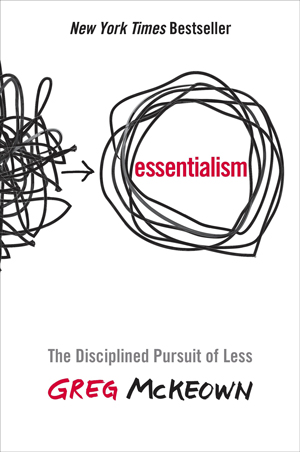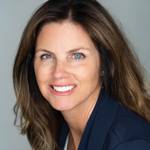Summary by Lisa Buck
Book by Greg McKeown
 Do you often feel busy but not productive? Stretched too thin?
Do you often feel busy but not productive? Stretched too thin?
The chaos of the modern workplace, where technology has blurred the lines between home and career, has led to overworked and unhappy professionals. The way out, according to author Greg McKeown, is to embrace essentialism.
“Essentialism” is a disciplined approach to strategically eliminate non-essentials in life, which allows us to focus on the essentials so we can make our highest contribution to the things that really matter. It is a way to reclaim control of where to spend our limited time and energy, instead of giving others the implicit permission to choose for us.
Essentialism is not about getting more things done; it’s about getting the right things done. The author sums it up with this mantra: Less but better.
The three steps of essentialism are: explore, eliminate, and execute.
EXPLORE: Discern the Vital from the Trivial
According to the author, almost everything is non-essential; it is noise. We must filter through to find the essential and eliminate the non-essential. An essentialist’s goal is to discern the vital few activities from the trivial many.
Power to Choose
We don’t always have control over our options, but we always have control over how we choose among them. If you surrender your ability to choose, someone or something else will do it for you.
Not all opportunities are equal. Certain types of effort yield greater rewards. The author cites the Pareto Principle, which states that about 80% of consequences come from 20% of causes, asserting an unequal relationship between inputs and outputs. In other words, 20% of our efforts produce 80% of our results. Find the efforts most likely to yield the results you want.
Trade-offs
Essentialists accept that most choices involve a trade-off, something we must forego. Saying yes to activity A might mean saying no to activities B, C, and D. Sometimes you will have to turn down good options.
The author points to Southwest Airlines as an example of how a company successfully navigated trade-offs (it does not fly everywhere, it does not serve food, it does not offer first-class seating) in order to serve its primary purpose: being a low-cost airline.
Distractions
In order to explore and evaluate your choices, it is helpful to create space to think, free of distractions. Some executives carve out specific time for this. Jeff Weiner, former CEO of LinkedIn, schedules up to two hours of blank space on his calendar each day to process and think. He considers this time to be his most valuable productivity tool.
Play
Play is vital and we should restore it into our adult lives. “Play” is anything we do simply for the joy of it, rather than as a means to an end. Examples include flying a kite, throwing a ball, listening to music, knitting, and doodling.
Play fuels creativity, exploration, adaptability, brain elasticity, and flexible thinking. Play helps us see possibilities and connections we would not otherwise see. We become more attune to novelty and unconventionality. These skills help us make wise choices.
To add play to your life, mine through your past and ask, 1) what did I do as a child that excited me? and 2) how can I recreate that today?
Organizations can create a playful culture by encouraging play at the office. A former CEO of Twitter, who had been a stand-up comedian, promoted play by providing an improvisation class for employees. At Google, you will find a Lego play area to stimulate creativity and reduce stress.
Sleep
Sleep is essential. It is not the enemy of productivity. Sleep is restorative to creativity and discernment. We are the greatest asset to our productivity and sleep allows us to “protect the asset”.
The author cites a study of world class violinists which found that the best violinists not only practice more, but they also sleep more than their musical peers. Better sleep leads to better practices, and better musicians.
ELIMINATE: Cut Out the Trivial
Once you have explored your options, it’s time to eliminate the non-essential. The Latin root of the word “decision” is cid or cis, which means to cut or to kill. Making a decision requires cutting out some things.
Clear Purpose
We want to eliminate any activity that is not aligned with what we are trying to achieve. Therefore, it is important to be clear about your purpose. Clarifying your purpose, like having a mission statement, makes it easier to identify and eliminate the non-essentials.
The author suggests that when making a choice, if it’s not a clear, definitive yes, then it’s a no.
One way to do this is to ask yourself, “If I didn’t already have this opportunity/activity, what would I be willing to do to acquire it?” That will help determine whether it is essential.
The Graceful No
Saying no can be uncomfortable, but being able to say no firmly and gracefully is a leadership skill. Remember, we say no to the non-essential so we can say yes to the things that really matter. In saying no, separate the decision from the relationship. Denying a request is not denying the relationship with the person making the request.
In fact, you don’t even have to use the word “no”. You might say:
“I’m flattered you thought of me, but I’m overcommitted at the moment.”
“Yes, I am happy to make project X the priority. Which of these other projects should I de-prioritize to focus on X?”
“I’m sorry I won’t be able to come in on Saturday. I’ve made a commitment to my family to spend every Saturday with them.”
EXECUTE: Make Doing the Essentials Effortless
Buffer
Life is unpredictable. Unexpected things happen—a colleague drops the ball, a supplier is late, the scope of a project expands, or a family member gets sick.
Though we cannot entirely prepare for the future, we can create a buffer for unexpected events.
A buffer is something that prevents two things from coming into contact with each other, such as the space you leave between your car and the vehicle in front of you when driving.
An essentialist’s buffer takes the form of extreme preparation. For example, add 50% to your time estimate of everything. Block off 90 minutes for a 1-hour Zoom meeting. If it takes 10 minutes to drive to court, leave 15 minutes before you want to arrive.
Built-in buffers reduce the friction caused by the unexpected.
Routine
Routines are powerful. A routine enables difficult things to become easier. Repetition strengthens the connections in our brain— just as it did when we were learning to talk or drive. Repetition also eliminates the mental cost of deciding and planning. Without a routine, non-essential distractions can overpower us.
Olympian Michael Phelps followed the same ritual at every race for years, starting with arriving two hours early, following a precise pattern of stretches and warmups, taking his earbuds out (always the right earbud first), and drying off the block before stepping up on it. Swimming was one more step in his routine. He never deviated from this routine, increasing his ability to focus and avoid distractions.
What about routines that are harmful or non-essential? According to Duke University researchers, about 40 percent of our choices are unconscious (such as checking your phone the second you get out of bed, or buying a triple mocha on the way to the office). We want to discard routines of non-essential habits and replace them with routines that will help make the essentials easier
Every habit has a cue (such as waking up or driving past a coffee shop), a routine (checking your phone or buying a mocha), and a reward (feeling updated or satiated). Find the cue that triggers your non-essential behavior. Each time you encounter the cue, replace your previous behavior with a new behavior. Done consistently, the link between the cue and the new behavior will be strengthened and become the default.
Some people have a daily routine, and others have a routine for different days of the week.
Jack Dorsey, co-founder of Twitter, devotes Mondays to management, Wednesdays to marketing and growth, and Fridays to company culture. Each day has a theme, making it easier to decide what is the priority that day.
Be Present
There is a difference between multi-tasking and multi-focusing. We can do two things at once, but we cannot concentrate on two things at once.
The author advises us to be fully present. Commit to being focused on one thing at a time. If you feel overwhelmed or pulled in different directions, pause and ask yourself: what is important right now?
He also suggests that we pause for a moment to refresh when we are changing environments. We may have left the office physically, but we can still be there mentally. Before walking into your house (or walking out of your home office into your house), close your eyes and take a deep breath to recenter and be fully present.
Conclusion
By exploring and evaluating many options, eliminating the non-essentials, and adopting habits to make executing the essentials easier, we can embrace the essentialist lifestyle and make a bigger contribution to the things that matter. We can produce more by doing less.
 Ms. Buck practiced corporate law in Minneapolis and was an adjunct professor at William Mitchell College of Law. When she isn’t writing for the Hennepin Lawyer, you can find her behind the lens at Lisa Buck Photography. buck.lisamarie@gmail.com
Ms. Buck practiced corporate law in Minneapolis and was an adjunct professor at William Mitchell College of Law. When she isn’t writing for the Hennepin Lawyer, you can find her behind the lens at Lisa Buck Photography. buck.lisamarie@gmail.com